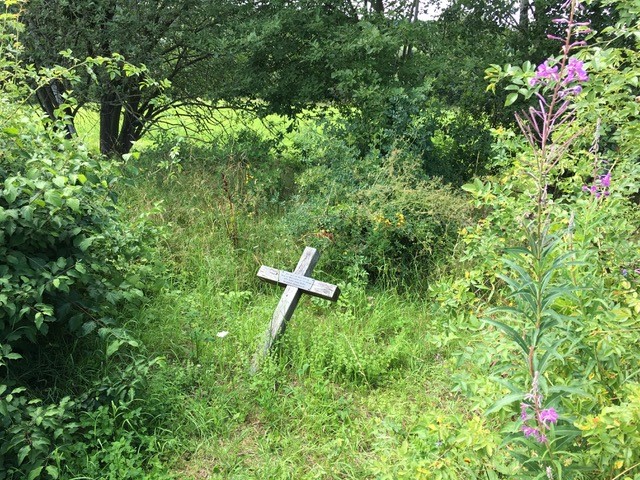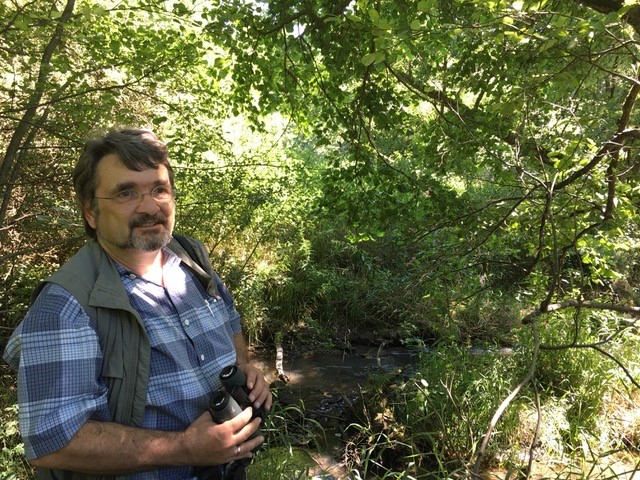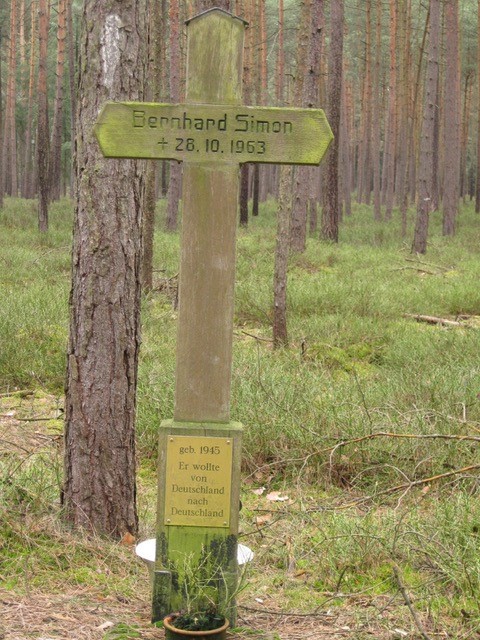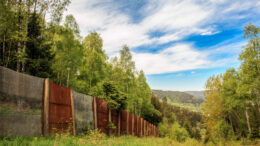During the four decades of the Cold War, one of the world’s most highly militarized borders cut across the landscape of my home country. The 900-mile-long German section of the Iron Curtain, to use Winston Churchill’s metaphor, was a strip of land several hundred feet wide, enclosed by fences and filled with trip wires, dog runs, minefields, vehicle ditches and other obstacles designed to keep East Germans from crossing west.
It was a ghastly thing. Every day border guards had to rake a 20-foot-wide “control strip” of bare soil along the fence so they could see the footsteps of anyone trying to cross. Even outside the border fence (but still on East German soil), they regularly cut trees and shrubs to maintain a clear line of sight to target anyone in case of potential escape. Nearly 500 people lost their lives trying to flee. Others suffered grievous wounds or were imprisoned for committing the crime of Republikflucht — fleeing the republic. Countless families were separated, dreams dashed, professional lives derailed.

The Berlin Wall, though less than one-tenth the length of the German-German border, came to symbolize the Iron Curtain and the Cold War division — perhaps never more strikingly than on Nov. 9, 1989, when it gave way to peaceful protesters. I watched the images, open-mouthed, on my TV in upstate New York, where I had emigrated two years earlier. I had never seen my fellow Germans so euphoric. If East Germans could simply walk into West Berlin, I thought, the longer border between the two German states had lost its purpose, too.
On visits over subsequent years, I reveled in discovering eastern Germany, connecting with those other Germans, walking in the footsteps of Bach and Goethe.
I didn’t think much about the border during those initial visits. It was gone, and that was good enough. It wasn’t until 20 years after Reunification that I finally wondered what had become of it — and then learned that it has become a long, skinny, bizarrely shaped nature preserve called the Grünes Band: Green Belt.

It’s nothing like the African Green Belt Movement, which focused on planting trees. Rather, the lack of commercial development and intensive agriculture allowed the border strip to serve as a refuge for plant and animal species that had become rare across the rest of the landscape. Bird species like European nightjars and northern lapwings, amphibians like moor frogs, plant species like western marsh orchids, and mammals like European wildcats and lynx.
Nature preserves don’t simply pop up in the landscape; they’re human creations. First, someone needs to notice and document species or habitats worth protecting. People need to do the unglamorous work of negotiating land purchases or trades, navigating legal protection categories, installing interpretive signs, and conducting biological inventories.
But first, someone has to notice.
What They Saw
Aside from the border guards, few people had paid much attention to the border while it stood. Most East Germans were not allowed within 3 miles (5 kilometers) of it. Many of the people who lived in what became the restricted zone were forcibly moved inland.
Though the human toll on the West German side was less drastic, the economic effects of the border were felt there, too. Businesses lost all customers and suppliers to the east. Jobs disappeared, and many residents moved away from what became known as the Zonal Borderlands. Granted, there was a certain degree of “border tourism.” But the West Germans and other foreigners who climbed onto viewing platforms to gaze at the border strip were generally more interested in the surreal grimness of the military installations than in the nearby flora and fauna.
One person who was paying close attention was a teenaged bird lover named Kai Frobel, who could see the border strip from his childhood home in Bavaria, in West Germany. It was the early 1970s — the height of the Cold War. During walks and bike rides, he noticed that he would see certain bird species only in the vicinity of the border strip.
He not only noticed but kept records of his observations, beginning when he was 13.
View this post on Instagram
On his rambles along the border, Kai was particularly taken with whinchats (Rubetra saxicola), small, brownish birds with orange-tan breasts and light eye stripes. From his forays along the borderline — careful not to step past the warning signs saying “Halt! Hier Grenze (Stop! Border here)” — he would often see whinchats perching on bushes, reeds, cabbage thistles, or the black-red-gold East German border markers. Like several other bird species that did well in the border strip, whinchats are ground breeders and need perches to survey their surroundings and see the insects they feed on.
“I learned to ID birds backwards,” Frobel said with a grin when I met him in the Green Belt for a walk recently. He’s now in his early sixties, with a gray-streaked beard. “The normal sequence is that you start with the common species and then expand your knowledge to the less common ones, and eventually you get to see some really rare ones. But growing up here next to the border, I practically stumbled onto rare and threatened species.”

Against all odds, he also made friends with a young East German birder named Gunter — through letters at first, and eventually through visits when 24-hour visas became available for West Germans.
When Kai was 17, he wrote up his whinchat records for a science contest and won first prize. The year was 1977. Winning was nice, he said, “but the important thing was that this was the first scientific documentation of the high biodiversity in the border strip.”
He followed it up a few years later with a more extensive survey conducted with a volunteer conservation group. “When the Berlin Wall fell and the border opened, we had very good data. We were well prepared to propose that this ribbon of land should be preserved as a feature in the landscape to protect that unusual biodiversity.
“Not that I ever expected that the border would actually open,” Frobel added. “Especially growing up here, seeing it every day — I really thought this monstrous thing was here for eternity.”
By the time the wall fell in 1989, he had gotten a Ph.D. in biogeography and begun to work for BUND, the German affiliate of Friends of the Earth.
As he and Gunter would later discover, their friendship had not escaped the attention of the Stasi, the East German secret police, which amassed hefty files on the two birders for their “subversive activities.” But their bond also helped them build a network of naturalists and conservationists — another critical factor in the story of the Green Belt.
A Movement Grows
The morning after the Berlin Wall fell, Frobel wrote postcards to all 24 contacts in their network, inviting them to a meeting to discuss the future of the border strip. When he arrived at the small restaurant where he had reserved a meeting room, the parking lot was nearly overflowing with Trabants, the basic-but-iconic East German car make. Just by word of mouth — these were the days before email and social media — his invitation had drawn 400 people to attend.
Convinced by the data Frobel presented, the group unanimously passed a resolution to call for the German government to protect the border strip as a feature in the landscape.
This, it turned out, was the easy part. Conservation, in Germany, is a matter of the federal states, nine out of 16 of which either include or abut segments of the former border. Consideration was due, too, to those people who had been forcibly removed from their homes in or near the border strip. They had received only minor indemnification from the East German state. At the same time, some who had chafed under the restrictions in the border zone felt that the Green Belt would be little more than another no-go zone, albeit without the military installations.
How, I asked Frobel, does one navigate a project that straddles conservation and historic preservation — and that aims to protect something that in the eyes of some should not be preserved at all?
“Right,” he reflected with a smile, “just imagine the atmosphere at the time, in December 1989. The border had been open for just a few days in some places, a few weeks in others. It was an amazing time. Everyone, myself included, was just elated that this border was finally gone. And then we conservationists come and say, folks, let’s preserve the border strip. That could really have backfired! We half-expected politicians to say: You guys are out of your minds.
“But we knew that there would soon be enormous pressure on this strip of land from agriculture and development,” Frobel said. “And fortunately, the resolution was well received, and the media did a good job explaining the significance.”

By Lencer – “own work”, used: Germany2 location map.svg by NNW, CC BY-SA 3.0, Link
No doubt the guided walks Frobel and his colleagues offered were helpful, too, as were the publicity materials BUND released. The message was compelling: “From Death Strip to Lifeline,” “Nature got a 40-Year Holiday,” “Borders Divide, Nature Unites.” The brochures made a point, too, of stating that the Green Belt could never retroactively justify the brutal border system. Frobel himself told me on our field walk that he thinks of the Green Belt as a landscape of both remembrance and renewal.
In the years after Reunification, a survey of the entire Green Belt documented 1,200 rare plant and animal species. It was a remarkable finding. Nature thrives when we humans leave it alone, seemed to be the lesson.
An Accidental Lifeline
The connection between military sites and biodiversity is not a rare phenomenon: Biological abundance has also burst forth in places like the Korean DMZ, the landscape around the Chernobyl nuclear plant, and abandoned military sites in the United States. Does it take military sites, of all places, to show us that our ecological footprint does not have to be one of destruction everywhere we step but can promote natural abundance? Could the paradox in BUND’s “Death Strip to Lifeline” narrative contain a message about our confused relationship to the rest of nature?
I carried these questions with me as I made my way along the Green Belt by bicycle a few years ago. It was a sort of trifold expedition during which I hoped to reconnect with my home country after 30 years abroad, learn what the border had meant in people’s lives, and understand what legacies it had left in the landscape.
Those legacies, it turns out, were still unfolding.
Somewhere between segments of my expedition I became aware of a study by biologist Stefan Beyer. Combining bird survey data from 1990 and 2011 with photo documentation along sections of the Green Belt, Beyer had noticed a perilous drop in biodiversity. Two of the typical, and endangered, Green Belt bird species had completely disappeared from the study sites. Three other species had declined by 66-90%. In the same period, 60% of previously open habitat had become overgrown or forested.
This was not entirely surprising. As anyone who tends to even a small garden patch knows, nature takes over the moment you look away. After a storm opens clearings in a forest, the seedlings and saplings of the next generation of trees quickly emerge and eventually close the canopy. Ecological succession occurs.
Still, Beyer’s findings were significant enough to prompt BUND to take a closer look at the nature of the border’s impact and revisit its management guidelines.
There’s no question that the military infrastructure had serious ecological consequences, especially where swaths were cut through forests or the hydrology of wetlands was altered. Mine fields were just as deadly for deer and other wildlife as they were for humans.

But Beyer also concluded that through their maintenance activities, the border guards had — albeit inadvertently — fostered near-perfect conditions for biodiversity.
To explain, Beyer pointed to a much earlier chapter in the story of Central Europe’s landscapes, one that began some 12,000 years ago after the last continental glacier retreated.
Once the scraped-bare rock had weathered into enough soil to support a pioneer suite of flora, animals moved back in. Trees and forests started to grow. Thunderstorms sparked fires, creating clearings. Large herbivores — wild horses, mammoths, and a prehistoric-looking kind of wild cattle called aurochs — did their part to keep the forest from closing back in. Contrary to the long-held view that much of Europe was covered with dense forest, the landscape took on a semi-open, mosaic structure of meadows and woods. Humans eventually domesticated or wiped out the large animals, but for a stretch of a few thousand years, small-scale farmers and herders continued to support a wide range of flora and fauna — along with the varied structure of the post-glacial landscape. Patch dynamics, ecologists call this type of process, in which a certain amount of disturbance promotes a high level of biodiversity.
Over time, then, different types of human activity had mimicked the effects of natural disturbances. A key outcome was a landscape pattern characterized by a high degree of ecotones: transitional or edge habitats like hedgerows or the transition between a forest and a meadow.
View this post on Instagram
The balance changed, geobotanist Hansjörg Küster has written, when intensive agriculture came to dominate the landscape in the middle of the 20th century. Ever larger plows and combines required ever larger fields and fewer hedgerows. Pesticides not only killed the intended targets but compounded up the food chain, leading to the near-extinction of species like white-tailed eagles. By the mid-1970s, large swaths of the West German landscape consisted of vast monocultures. In East Germany collectivization of agricultural lands had produced giant expanses of farm fields even earlier.
The way natural scientists like Beyer and Küster see it, it was in precisely this chapter of the European landscape story that history, in the form of the Iron Curtain, threw an accidental lifeline to the beleaguered flora and fauna. The border strip — as deadly as it was for humans and other mammals — had created a semi-open, layered landscape beyond the reach of plows, fertilizers, and pesticides. In and along that narrow band were habitats that supported a wide range of different species. Not the aurochs or wild horses, but mammals like lynx and European wildcat and birds like the whinchat and black stork. All in all, BUND’s surveys documented 146 habitat types, from fens and bogs to nutrient-poor grasslands and alpine meadows. This was not a wilderness untouched by humans. And like all landscapes, it was not static but dynamic. To maintain the Green Belt’s remarkable biodiversity in the coming decades would require humans to take an active role. At a 2011 symposium, Beyer, Frobel, and other experts developed a set of management strategies based on the guiding principle of fostering a semi-open, layered landscape. Depending on the habitat type, that could mean measures like brush-hogging, sheep-grazing, or rewilding with semi-wild breeds of horses or cattle.
Human Hands
I once loved the idea of the Green Belt as a wild corridor in the middle of my densely populated home country, freed both from military installations and other human impact. I still love the idea of wilderness as something larger than our human selves and see an urgent need for places where ecological processes dominate the landscape, rather than human designs. But all too often in history the idea of wilderness has served to erase the human presence in a landscape, both in narratives and by actual removal of humans from the land.
Here, then, is the flip side of the border–Green Belt paradox. As environmental historian William Cronon puts it, “the notion of wilderness embodies a dualistic vision in which the human is entirely outside the natural. If we allow ourselves to believe that nature, to be true, must also be wild, then our very presence in nature represents its fall.”
As if we humans actually could exist outside the natural world, I thought as I rode my bike along a stretch of the Green Belt, listening to the wild duetting calls of a pair of cranes.
“The test of a first-rate intelligence is the ability to hold two opposed ideas in mind at the same time and still retain the ability to function,” F. Scott Fitzgerald wrote years before the Iron Curtain descended across the landscape. His words traveled with me as I tried to fathom the paradoxes of this time and place. Humans and nature. The frequent memorials for people who had died along the border, and the silver lining in the legacy of life it left.
And as the legacy became clearer over the past 30 years, we’ve seen biodiversity plummet on a global scale. The 2022 UN Biodiversity (COP15) report handed our species not only a dire warning for our own continued existence but also a large chunk of responsibility for the staggering loss of species.
What if we recognized the human-nature divide as an illusion? Could the glimpse into earlier cultural landscapes that the Green Belt provides help us think of nature as our ecological home?
Biologist Bernd Heinrich reminds us in his book The Homing Instinct that home is where what you do has consequences, and where you expect and get feedback — both positive and negative — from what you do. That feedback is perhaps the main, if not the only, mechanism that maintains balance with the environment that we deem relevant to us.
But homes are also places with which we are familiar. And that is exactly the challenge many of us face regarding our ecological homes: we are not familiar with what is around us. If we can’t tell one species from another, how can we even notice the loss of biodiversity? Author Robert Michael Pyle calls this the extinction of experience. One study found that children can recognize on average 1,000 different corporate logos but only a few plants and animals native to the area they live in.
This was disturbing. To cheer myself up, I recently arranged a visit at a Waldkindergarten — a forest preschool near the Green Belt. Groups of two or three children were scattered around a clearing. Some were balance-walking across a downed log, two were taking turns on a simple board-and-rope swing attached to a sturdy tree branch. Other kids were half-hidden by ferns and saplings, pointing to something I couldn’t see.
Then I noticed a little girl arranging leaves on a log. I walked over to her and told her my name. She glanced up at me, a look of concentration and contentment on her face. She couldn’t have been more than four or five years old.
“I’m Emma,” she said. “Do you want to help me collect leaves?”
“Sure,” I said. “What kind would you like?”
“I could use some beech leaves, and maybe some hazel. So far I have mostly oak,” she replied, then turned back to her log.
She’s at home right here, I thought, and she can tell one tree species from another.
Could it be so easy? Might we solve the crisis of biodiversity by sending our children to forest preschools and having adults take botany and zoology courses?
Ecological literacy and a connection with the natural world may not be the whole story, but they’re foundational. What we do with our ecological knowledge is the next question.
The spring 2023 BUND magazine reports that whinchats — the poster-child birds of the Green Belt — remain very endangered. But the article contains some silver linings, too. In a program adjacent to a northern segment of the Green Belt, not far from little Emma’s pre-school, BUND pays farmers a premium to mow later in the season so whinchats have time to get their broods off the ground — literally. Farmers are also asked to install perching posts. On the other side of the river Elbe (a 70-mile stretch of which overlapped with the Iron Curtain), a levee was moved inland to restore 400 hectares of floodplain forest and meadows. In both cases the number of breeding pairs of whinchat went up significantly.
Such programs speak directly to the question of how we humans relate to nature: How we produce our food and energy is about as fundamental as it gets.
What Kai Frobel’s resolution recognized in 1989 — the former border strip’s role as an ecological corridor across Germany and a landscape of remembrance — has increasingly found broader recognition. The Green Belt was anchored in Germany’s federal Law on the Conservation of Nature in 2009, and three federal states have, so far, designated it as a National Monument of Nature — Germany’s newest conservation category. As of January 2024, the Green Belt is a candidate for UNESCO’s natural and cultural heritage lists. All of this recognizes the former border strip’s natural, cultural, and historical significance within and beyond the reunited country.
And of course, it has immense, ongoing personal significance. That’s part of Kai Frobel’s vision for the Green Belt. “I dream of the Grünes Band,” he told me on our walk, “as an alternative Camino de Santiago, a kind of pilgrimage route that allows people to retreat from the noise of everyday life. A place to come for Besinnung” — reflection and awareness.
I nodded, moved by the arc of this man’s life and work. What better place than this path of loss and silver linings to find our home on this planet.
Previously in The Revelator:
The Final Frontiers? A Call to Protect the Biodiversity on the Borders



